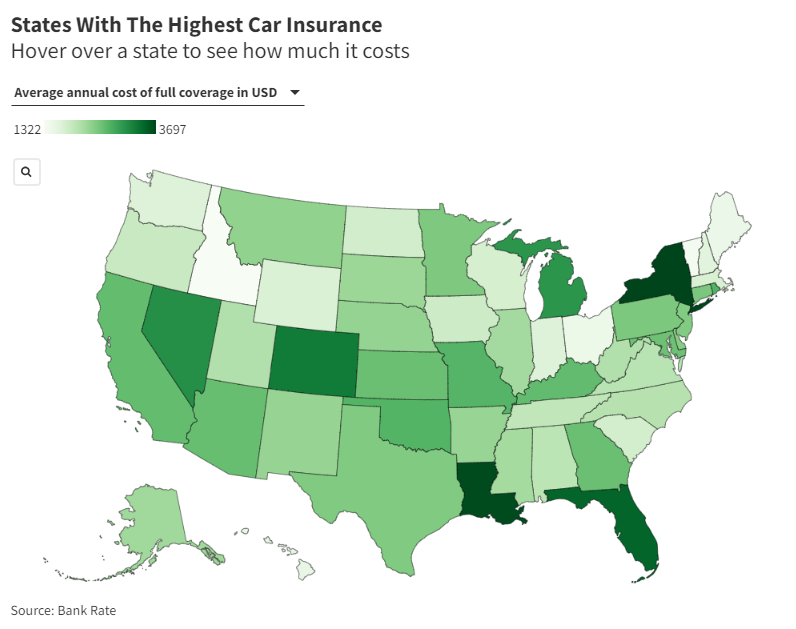For drivers, where you choose to live can significantly impact your auto insurance costs.
While some states offer more affordable rates due to favorable conditions like lower population density and fewer accidents, others face significantly higher premiums.
As the cost of car insurance continues to rise generally, drivers should be aware of these state-by-state differences to help them select the best rates available.
Newsweek has created this map to show the states with the highest car insurance rates, using data gathered by Bankrate.
Its recent analysis reveals significant disparities in auto insurance rates across the United States.
Bankrate used Quadrant Information Services to analyze August 2024 rates for all ZIP codes and carriers from across the country.
Rates are weighted, based on the population density in each geographic region, reflecting the varying risk factors and demographics that influence insurance premiums across different geographic areas.
New York leads the way, with an average cost of $3,697 for full-coverage auto insurance. The state has high urban populations and dense traffic, which increases the likelihood of accidents and claims.

ANGELA WEISS/AFP via Getty Images
Mark Friedlander, director of corporate communications at the Insurance Information Institute, told Newsweek: “Drivers in high-density states like New York typically pay more for car insurance than drivers in a low-density state like Idaho.
“This is due to the variances in accident frequency and severity, higher costs of repairs, and more expensive medical treatment. More congested highways lead to higher accident rates.
“We are seeing a trend of more severe accidents across the country. Riskier driving behaviors, like speeding and distracted driving, cause more severe impact crashes, resulting in increased fatalities and severe injuries.
“The cost of auto insurance reflects the expected losses paid to policyholders. When losses increase, insurance premiums will also rise.
“For the aggregate U.S. auto insurance industry, carriers’ incurred losses increased 53% from 2020 to 2022 due to escalating accident frequency and severity.”
The report identified Louisiana as the second-most expensive state for auto insurance, with an average annual premium of $3,646.
Florida follows closely behind at $3,451. Rounding out the top five are Colorado and Nevada with $3,259 and $3,074, respectively.
The variation in rates across states can be attributed to several factors. Population density plays a significant role; states with higher urban populations tend to have more traffic accidents, driving up the cost of claims.
Additionally, states with high rates of uninsured drivers force insurance companies to cover more risk. Weather-related issues are another crucial factor; states prone to hurricanes, floods, or other natural disasters often see higher insurance rates due to the increased likelihood of claims.
On the other end of the spectrum, Idaho boasts the lowest average annual premium at $1,104. The state’s lower population density and fewer accident claims help keep rates down.
Robert E. Hoyt, professor of risk management and insurance at the University of Georgia, told Newsweek insurance premiums are “impacted by the expected frequency and severity of losses.”
“Frequency is impacted by density of vehicles (urbanization), driving behavior, and other factors. Severity is impacted by factors such as repair costs, medical costs, litigation costs and damage awards, the prevalence of insurance fraud, and other factors. Natural disaster hazards like hail, hurricanes, and flooding also impact both the frequency and severity of losses. Many of these factors vary significantly across different regions of the country and across states.
“Idaho is a relatively less populous state, which leads to lower vehicle density on its roads. Additionally, it has historically been less prone to natural hazard losses, generally faces lower litigation costs, and has been less impacted by insurance fraud.”
Vermont follows with $1,385 on average for full coverage annually, while Ohio comes in at $1,497. Maine and Hawaii have average premiums of $1,505 and $1,543, respectively.
These states benefit from a combination of factors, including fewer accidents, lower repair costs and fewer natural disasters compared to the more expensive states.
Do you have a story Newsweek should be covering? Do you have any questions about this story? Contact LiveNews@newsweek.com
